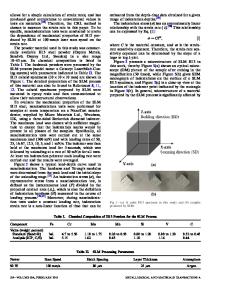Microstructural heterogeneity and mechanical anisotropy of 18Ni-330 maraging steel fabricated by selective laser melting
- PDF / 1,818,985 Bytes
- 12 Pages / 584.957 x 782.986 pts Page_size
- 25 Downloads / 338 Views
FOCUS ISSUE
ADDITIVE MANUFACTURING OF METALS: COMPLEX MICROSTRUCTURES AND ARCHITECTURE DESIGN
Microstructural heterogeneity and mechanical anisotropy of 18Ni-330 maraging steel fabricated by selective laser melting: The effect of build orientation and height Yi Yao1, Kaiwen Wang2, Xiaoqing Wang3,4,a), Lin Li1,b), Wenjun Cai2,c), Samuel Kelly3,4, Natalia Esparragoza3,4, Matthew Rosser3,4, Feng Yan1 1
Department of Metallurgical and Materials Engineering, The University of Alabama, Tuscaloosa, AL 35401, USA Department of Materials Science and Engineering, Virginia Polytechnic Institute and State University, Blacksburg, VA 24061, USA Department of Applied Engineering, Jacksonville State University, Jacksonville, AL 36265, USA 4 The Center for Manufacturing Support, Jacksonville State University, Jacksonville, AL 36265, USA a) Address all correspondence to these authors. e-mail: [email protected] b) e-mail: [email protected] c) e-mail:[email protected] 2 3
Received: 5 February 2020; accepted: 5 May 2020
Distinguished by a marked combination of high strength and high fracture toughness, 18Ni-300 maraging steel (MS) is widely used for intricate tool and die applications. MS is also amenable to the powder bed fusion additive manufacturing process, providing unique opportunities to make small features and incorporate cooling channels in molds. In this study, tensile test samples were fabricated using selective laser melting to investigate the effects of built height and orientations on the evolution of the microstructure and the mechanical properties of the samples. The microstructure of the as-fabricated samples consists of the primary α-martensite phase and fine cellular microstructure (∼0.66–0.83 μm) with the retained austenite γ-phase aggregated at the boundaries of the cells, resulting in an enhanced mechanical performance compared with traditional counterparts under the same condition (without post-heat treatments). Random grain orientations with weak textures are revealed in all samples. The XY-built samples display better tensile performance when compared to the Z-built samples due to the fine grain sizes and the retained γ phase. The bottom of the Z-built sample exhibits a higher hardness than other parts of the sample, which could be attributed to its finer cellular structure.
Introduction Powder bed fusion (PBF) is one of the most mature and widely used additive manufacturing (AM) process, during which the powdered material is selectively consolidated by melting using a heat source such as laser [1] or electron beam [2]. As one of the typical PBF–AM process, the laser PBF–AM process, also named as selective laser melting (SLM) or direct metal laser sintering (DMLS), can produce functional metal components with nearly full density, high-dimensional precision, good surface integrity [3], and outstanding mechanical properties [4, 5]. SLM is applicable to various metals, such as Inconel alloys [6] and steels [7], and it has a strong appeal to the industry targeting low-volume production for specific applications [8] as
Data Loading...











